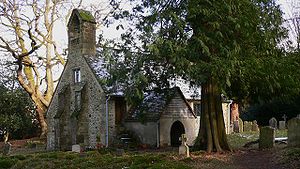- Tuxlith Chapel
-
Tuxlith Chapel Milland Old Church 
Tuxlith Chapel from the southwestLocation in West Sussex Coordinates: 51°02′52″N 0°49′26″W / 51.0478°N 0.8238°W OS grid reference SU 825 282 Location Milland, West Sussex Country England Denomination Anglican Website Friends of Friendless Churches Architecture Functional status Redundant Heritage designation Grade II Designated 18 June 1959 Architectural type Church Style Gothic Completed 18th century Closed 1879 Specifications Materials Plastered stone rubble with ashlar dressings, tiled roof Tuxlith Chapel, also known as Milland Old Church, is a redundant Anglican church in the village of Milland, West Sussex, England (grid reference SU 825 282). It has been designated by English Heritage as a Grade II listed building,[1] and is under the care of the Friends of Friendless Churches.[2]
History
It has been stated that the church was built as a chapel of ease to St George, Trotton, in the 16th century.[3] However there must have been an earlier building on the site because during conservation work a blocked window dating from the 12th century, and herringbone masonry in the north wall in Norman style were found.[2] The earliest surviving documentary evidence relating to the church is a bequest in a will dated 1532 to "the Church of Tyklyth".[2] The parish registers go back to 1581. In the 17th century a gallery was added, approached by steps from outside the church. During the following century a north transept was built. However during the 19th century, due to growth of the local population, the building became too small for the size of the congregation, and a new church dedicated to St Luke was built to the west of it in 1879.[2]
The old church was used as a Sunday school until the 1930s, when it became unused and its fabric deteriorated.[2] It was listed as Grade II listed building in 1959, at which time it was described as being "disused and neglected".[1] The church was declared redundant in 1974.[2] It was one of the first churches to be owned by the charity, the Friends of Friendless Churches.[4] At that time the charity was only a pressure group, but its constitution was changed so that it could instigate repair and renovation of the churches in its possession.[4] The charity holds a 99 year lease with effect from 1 January 1974.[5] After its acquisition the building was immediately made waterproof.[2] Money has since been raised for further restoration work, helped by the Friends of Tuxlith Chapel, a group founded in 1993. It is now used as a community centre, and it hosts concerts and meetings.[4] Improvements to the furniture of the church have been undertaken, including restoration of the pulpit in 1993, and a new altar designed by Sir Hubert Bennett.[2]
Architecture
Tuxlith Chapel is constructed in plastered stone rubble with ashlar dressings and has a tiled roof.[3] Its plan is L-shaped, consisting of a chancel with a north transept and a north porch, and a nave with a south porch. On the south wall are stone steps which led up to the former gallery.[1] On the west gable is a bellcote.[3] On the sides of the east window are Commandment Boards containing the Creed and the Lord's Prayer.[6]
Contrasting it favourably with St Luke's Church, its 19th-century replacement, architectural historian Nikolaus Pevsner described it as making "a very telling contrast between true piety and 19th-century religious advertisement".[7]
References
- ^ a b c "Milland Old Church", Heritage Gateway website (Heritage Gateway (English Heritage, Institute of Historic Building Conservation and ALGAO:England)), 2006, http://www.heritagegateway.org.uk/Gateway/Results_Single.aspx?uid=411656&resourceID=5, retrieved 22 July 2010
- ^ a b c d e f g h Milland, Friends of Friendless Churches, http://www.friendsoffriendlesschurches.org.uk/CMSMS/index.php?page=milland, retrieved 22 July 2010
- ^ a b c Salzman, L. F., ed. (1953), "Trotton", Victoria County History (University of London & History of Parliament Trust) 4: The Rape of Chichester: pp. 32–39, http://www.british-history.ac.uk/report.aspx?compid=41691#s3, retrieved 22 July 2010
- ^ a b c Larner, Catherine, "Brought back from neglect and decay", Church Times (7527), 15 July 2007, http://www.churchtimes.co.uk/content.asp?id=40569, retrieved 22 July 2010
- ^ Churches and chapels owned by the Friends of Friendless Churches: Details for Visitors, London: Friends of Friendless Churches, June 2010
- ^ Saunders, Matthew (2010), Saving Churches, London: Frances Lincoln, pp. 79–81, ISBN 978-0-7112-3154-2
- ^ Nairn, Ian; Pevsner, Nikolaus (1965). The Buildings of England: Sussex. Harmondsworth: Penguin Books. p. 274. ISBN 0-14-071028-0.
Categories:- Grade II listed buildings in West Sussex
- Grade II listed churches
- Churches preserved by the Friends of Friendless Churches
- 18th-century architecture
- English Gothic architecture
Wikimedia Foundation. 2010.

